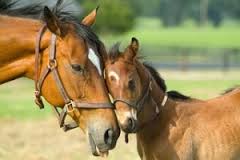Horses share some surprisingly similar facial expressions to humans and chimps, according to new research.
Mammal communication researchers have shown that, like humans, horses use muscles underlying various facial features — including their nostrils, lips and eyes — to alter their facial expressions in a variety of social situations.
The study builds on previous research showing that cues from the face are important for horses to communicate, by developing an objective coding system to identify different individual facial expressions on the basis of underlying muscle movement.
The study’s co-lead author, doctoral researcher Jennifer Wathan, said: “Horses are predominantly visual animals, with eyesight that’s better than domestic cats and dogs, yet their use of facial expressions has been largely overlooked. What surprised us was the rich repertoire of complex facial movements in horses, and how many of them are similar to humans.
“Despite the differences in face structure between horses and humans, we were able to identify some similar expressions in relation to movements of the lips and eyes.
“What we’ll now be looking at is how these expressions relate to emotional states.”
The researchers analysed video footage of a wide range of naturally occurring horse behaviours to identify all the different movements it is possible for horses to make with their face. They also carried out an anatomical investigation of the facial muscles that underpin these movements. Each individual facial movement that was identified was given a code.
Co-lead author Professor Karen McComb said: “It was previously thought that, in terms of other species, the further away an animal was from humans, the more rudimentary their use of facial expressions would be.
“Through the development of EquiFACS, however, it’s apparent that horses, with their complex and fluid social systems, also have an extensive range of facial movements and share many of these with humans and other animals. This contributes to a growing body of evidence suggesting that social factors have had a significant influence on the evolution of facial expression.”
She added that a systematic way of recording facial expressions would have a wide range of uses. We can now document the facial movements associated with different social and emotional contexts and thus gain insights into how horses are actually experiencing their social world. As well as enhancing our understanding of social cognition and comparative psychology, the findings should ultimately provide important information for veterinary and animal welfare practices.
Source: Science Daily
N.H.Khider

